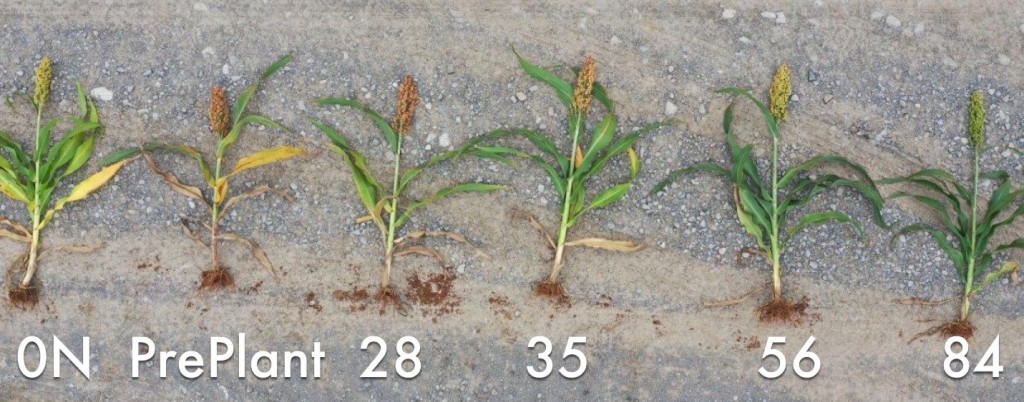Michaela Smith, Masters student under advisement of B. Arnall
Brian Arnall, Precision Nutrient Management Specialist
Grain sorghum producers in Oklahoma are challenged greatly by their environment and sporadic rainfall patterns, which diminish as the season progresses. These uncontrollable variables influence timing of nitrogen (N) application and nitrogen use efficiency. Using rainfall events as an incorporation method forces producers to apply before the event regardless of its intensity or delay application until field conditions are acceptable while anxiously waiting for another rainfall event. When deciding to delay N application it’s important to know the effects on physiological development and grain yield.

Trial structure and breakdown
This study was conducted over the 2020 growing season consisting four locations, including one double cropping system following wheat. Ten in-season applications were made using ammonium nitrate (AN) as the N source at a rate of 90 lbs. ac. Using AN as the N source reduced the risk of nitrogen loss through the process of volatilization as the goal of the research was to test the plant not the fertilizer. A pre-plant treatment served as the standard check, while in-season applications were initiated at 21 Days After Planting (DAP) and applications made sequentially at 7-day intervals. A non-fertilized check was included to the study to confirm locations were responsive to N fertilized applications Hybrid, plant date, and seeding rate can be found in Table 1.

Physiological Response to Application Timing
Two of the four locations demonstrated an effect to physiological development and maturity with the delay of nitrogen application. A delay in heading by a one to two-week period was observed at Perkins and Lahoma for applications made after May 21st (Table 2.). This delay in heading contributed to similar delay in maturity and potential harvest date. At Perkins decreased plant height was observed in the pre-plant plot and was associated with the onset of late season nitrogen deficiency (Figure 2). While this response was unexpected, the impact of nitrogen deficiency experienced early in the crop growth on the root and shoot growth has been well documented in many species. As a plant experiences nitrogen limitations growth changes from above ground to the below ground parts (roots) in an attempt to alleviate nitrogen stress. This increase in root growth could contribute to a more efficient uptake of nitrogen and decrease loss. In contrast to Figure 2, pre-plant application is shorter than compared to later season applications, this could be a result of inadequate N uptake thus leading to N loss by leaching, whereas later applications had increased root growth for efficient N interception and uptake.


Yield Response to Application Timing
Response of N was observed at all locations (Figure 3), while the delay of nitrogen varied in its effects across all locations. Grain yield from each N application was compared back to the pre-plant application to evaluate the effects of timing. All four locations responded positively to N fertilizer. At both LCB and Lahoma grain yield was maintained with applications made as late as 42 to 63 DAP respectively before any negative trend in grain yield was observed. Perkins was the only locations to have a statistically significant increase in grain yield due to delayed N applications. At this site, which is a sandy loam, waiting until 42 DAP resulted in a 15 bushel increase over the pre-plant plot. Now Alva which was double crop showed that rainfall is key. At this site, none of the in-season treatments made it up the level of the pre-plant. The reason for this will be discussed further below.

Influence of Rainfall
The loss in grain yield at Perkins in the pre-plant application could likely be reflective of nitrogen loss due to leaching. Pre-plant applications have been well documented in the aspect loss as a result of crop requirement and early physiological development. Long term mesonet rainfall data depicts a decline in the probability of rainfall with the progression of the growing season across all locations. In early season the probability of 0.5 inches of rainfall ranges from 8 to 10% respectively for LCB, Lahoma, and Perkins, and dramatically decline to percentages at low as 5% in mid-July during grain filling period. For Alva rainfall probability is substantially lower as its season was initiated during the drier months, which depicted a probability of 6% for 0.5 inches of rainfall, and 4.5% for 1 inch for early season rainfall crucial for pre-plant incorporation and crop establishment. These probabilities drop considerably compared to regular season as the months progress onward, mid to late August probability for 0.5 inches ranges from 0.8 to 11.5%, while for a 1 inch is 0 to 6.9%. Past weather data provided by the mesonet illustrates how later in the season rainfall and its amount is variable, suggesting that in a double crop scenario delayed application is not recommended while it is in regular season crop due to the increased chance of rainfall probability.
Summary
The purpose of this study was to evaluate the impacts of delayed nitrogen application in grain sorghum. In order to develop an accurate conclusion additional site years are required, although current data could suggest delaying nitrogen application for full season grain sorghum is possible without a detrimental loss in grain yield. This means producers have time to evaluate the crop and market to determine if more inputs are needed and economical, while allowing implementation of technologies such as the N-Rich Strip and SBNRC.
If you have any questions for comments please reach out.
Brian Arnall
b.arnall@okstate.edu
405.744.1722
Acknowledgement of EDC Ag Products Co LLC for support of this project.
